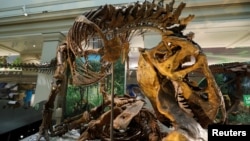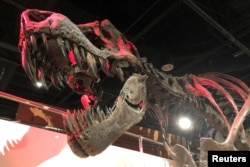On February 20, 1824, British scientist and Christian clergyman William Buckland spoke before the Geological Society of London. He described the find of a huge jaw and other bones at a rock mine in the village of Stonesfield near Oxford, England.
Buckland recognized that these fossils belonged to a huge reptile of the long past. He gave it the scientific name Megalosaurus, meaning "great lizard."
With that, the first dinosaur was officially recognized, although the word dinosaur did not come for several more years.
Buckland’s talk "was the beginning of our fascination with dinosaurs," says University of Edinburgh paleontologist Steve Brusatte.
"His announcement opened the flood gates,” he said, and many people launched their own fossil hunts.
“People went out looking for other giant bones in England and beyond," Brusatte said.
In the almost 200 years since, dinosaur science has ballooned. Researchers have learned much about how these creatures looked, lived and developed, or evolved. Scientists also learned what caused the disappearance of the ancient animals.
Dinosaurs lived from about 231 million years ago to 66 million years ago during the Mesozoic Era. They are ancestors to birds of today. Science has identified over 2,000 species of dinosaur.
"Our understanding of dinosaurs has changed significantly since the 19th century," said paleontologist Emma Nicholls of the Oxford University Museum of Natural History. It is home to the Megalosaurus fossils that Buckland studied.
By the 1840s, other dinosaur researchers were learning that some dinosaurs walked on four legs and others walked on two legs. The Megalosaurus belongs to a group known as theropods. The group also includes meat-eaters Tyranosaurus and Spinosaurus, animals which “scampered” on their legs. Both species grew to about 9 meters tall and used their sharp claws and strong, toothy jaws to overpower prey, Brusatte said.
Evidence of dinosaurs has been found all around the world. The first complete dinosaur skeletons were set up in the 1870s.
In the 1960s, the discovery of a small dinosaur changed popular thinking about the animal group. Deinonychus was a fast-moving meat-eater. Some smaller dinosaurs, like Archaeopteryx, were found to be very much like early birds in body structure. The new research confirmed how birds evolved from small, feathered dinosaurs.
In the years that followed, scientists used new imaging tools to learn more about how dinosaurs grew and moved. Other tools permitted them to make good guesses about their colors, because some dinosaur remains had small pieces of skin or feathers that contained pigment, or color.
Thomas Holtz is a paleontologist at the University of Maryland. He said all of the research created “a more dynamic and biological view of dinosaurs as living things.”
In recent years, fossils have been found in China, Argentina, Brazil, South Africa and Mongolia.
Hans-Dieter Sues is a paleontologist at the Smithsonian Institution’s National Museum of Natural History in Washington, D.C. He said the most important recent discovery is that the theropods were covered with feathers although they could not fly. He said the feathers kept the dinosaurs warm and were used for show.
One question that concerned scientists from the beginning was why the dinosaurs died. They came up with many theories. One scientist even said small mammals might have eaten all the dinosaur eggs.
Scientists have since settled on an answer. They believe an asteroid that hit the Earth in what is now southern Mexico was to blame for the disappearance of dinosaurs. Experts believe the event destroyed about 75 percent of life on Earth, including all its dinosaurs.
But what if there had been no asteroid? Would dinosaurs still rule the world today?
Holtz of the University of Maryland says “almost certainly, yes.” He notes that some mammals existed at the time of dinosaurs but they were all small. He said dinosaurs would have needed to evolve as the Earth cooled and some forests dried out.
In the last 200 years, scientists also have a better idea of the largest and smallest dinosaurs. One 2023 study said the largest dinosaur was Argentinosaurus, which measured about 35 meters long and weighed 76 tonnes.
But Holtz said there is still more research to be done.
He said many areas of the world have not been explored by paleontologists. That offers hope of more dino finds.
“There are almost assuredly entire groups of dinosaurs which we currently know nothing about waiting to be discovered,” Holtz said.
I’m Caty Weaver. And I’m Dan Friedell
Will Dunham reported this story for Reuters. Dan Friedell adapted the story for Learning English based on a report by Reuters.
_______________________________________________
Words in This Story
fossil –n. something (such as a leaf, skeleton, or footprint) that is from a plant or animal which lived in ancient times and that you can see in some rocks
fascination –n. a great interest in something
giant –adj. extremely large
significantly –adj. to a large and notable degree
scamper –v. to run very fast, but usually related to a small creature
claw –n. a sharp nail attached to a hand or finger of an animal
prey –n. an animal that is the food of another animal
skeleton –n. the connected bones of an animal without skin
dynamic –adj. something that has a lot of energy and interest
We want to hear from you. Do you have someone in your family who is interested in dinosaurs?
















Forum